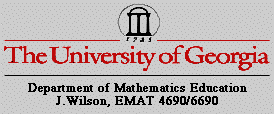

Circles and Spheres Instructional Unit
by
Nathan Wisdom
Unit Overview
This unit is designed for the Accelerated Mathematics1 course and is to be used concurrently with the Georgia performance standards Unit 3: Circles and Spheres. The goal of this unit is to provide a collection of materials, that will harness the power of technology so that students will be better able to understand and apply the mathematics. Using the technology will allow students to visualize, investigate and solve more difficult problems than in the traditional mathematics classroom.
In this unit students will use dynamic geometry to investigate and explore the properties of circles. Students will use these properties to solve problems involving arcs, angles, sectors, chords, tangent lines and secant lines. The unit requires the use of The Geometer's sketchpad (GSP) and or Geogebra. It is assumed that GSP is available in schools and that students are familiar with its use. A comprehensive professional development guide is located here http://www.dynamicgeometry.com/Documents/GSP_Wshp_Guide.pdf . This guide is appropriate for classroom use. Geobra is a FREE software and can be used either as a web-base client or stand-alone client. You can get geogeba from http://www.geogebra.org/cms/ . The Geogebra wiki has a large pool of materials for both teachers and students. Please visit the Geogebra wiki here http://www.geogebra.org/en/wiki/index.php/English. Depending on the background of the class, some training on the software may be needed. It is strongly advised that the teacher uses a part of day one for free play (learning the software) and definitions.
This unit will also use materials from project Intermath. To learn more about project Intermath, please go here http://intermath.coe.uga.edu/about/homepg.htm .
MA1G4. Students will understand the properties of circles.
a. Understand and use properties of chords, tangents, and secants as an application of triangle similarity.
b. Understand and use properties of central, inscribed, and related angles.
c. Use the properties of circles to solve problems involving the length of an arc and the area of a sector.
d. Justify measurements and relationships in circles using geometric and algebraic properties.
MA1G5. Students will find and compare the measures of spheres.
a. Use and apply surface area and volume of a sphere.
b. Determine the effect on surface area and volume of changing the radius or diameter of a sphere.
Day 1: Basic Terms and Constructions.
Use Geometer's Sketchpad or Geogebra to explore the following definitions. Provide a well labeled diagram to illustrate each definition.
GSP File For investigation and other definitions.A circle is the set of all points in a plane that are equidistant (the length of the radius) from a given point, the center, of the circle
|
 |
A chord is a segment on the interior of a circle whose endpoints are on the circle
|
|
| A diameter is a segment between two points on a circle, which passes through the center of the circle. | |
|
A sector of a circle is a region in the interior of the circle bounded by two radii and an arc of the circle. |
|
A secant line is a line that intersects a circle at two points on the circle.
|
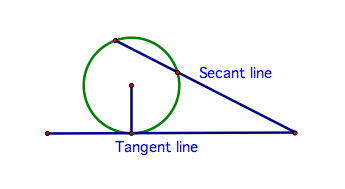 |
| A tangent line is a line that intersects the circle at exactly one point | |
An arc is a connected section of the circumference of a circle. An arc has a linear measurement, which is the portion of the circumference, and an arc has a degree measurement, which is a portion of the 360 degree circle.
|
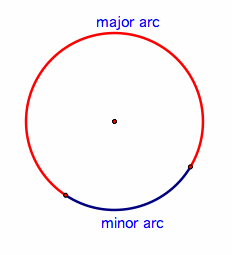 |
If a circle is divided into two unequal arcs, the shorter arc is called the minor arc and the longer arc is called the major arc
|
|
| If a circle is divided into two equal arcs, each arc is called a semicircle. | 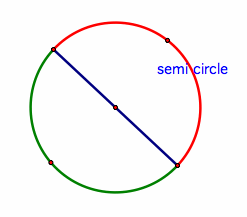 |
|
A central angle of a circle is an angle whose vertex is the center of the circle. |
Day 2 Arcs.
GPS Element :Use the properties of circles to solve problems involving the length of an arc and the area of a sector.
Definition of Arc Measure: The measure of an arc is the measure of its central angle.
Definition of Arc length: The linear length of an arc is a part of the circumference, proportional to the measure of the central angle when compared to the entire circle.
Arc Addition Postulate: The measure of an arc formed by two adjacent arcs is the sum of the measure of the two arcs.
Congruent Circles: Two circles with the same radii
Congruent Arcs: Two arcs with the same measure that are arcs of the same circle or congruent circles.
Investigation and Problem Solving
1. Construct two congruent circles that (a) are disjoint, and (b) intersecting. Describe the construction and explain why the circles are congruent.
2. Draw diagrams to illustrate and explain how it is possible for two central angles to be congruent yet their corresponding minor arcs are not congruent.
3.
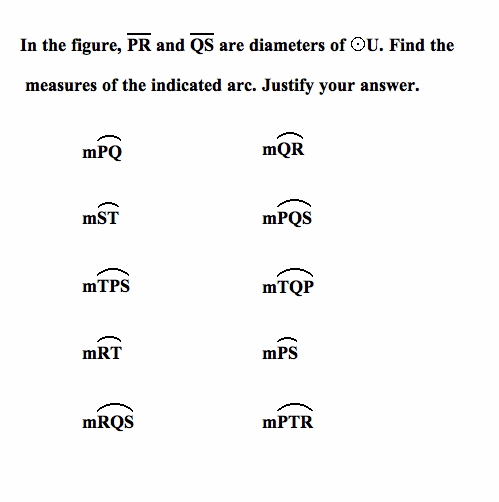 |
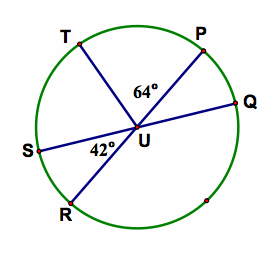 |
4.
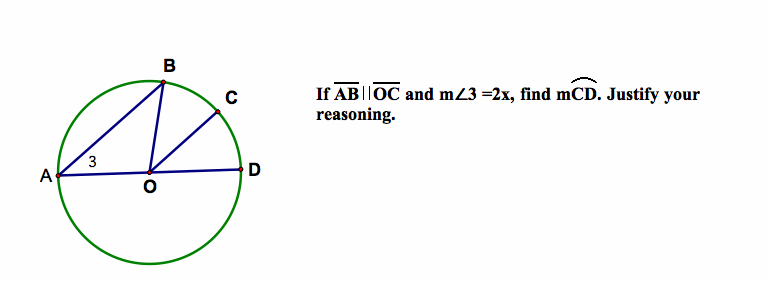
5.
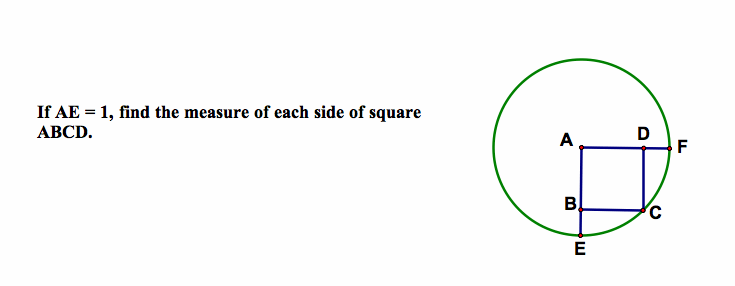
6. Using GSP construct a circle. Construct a sector of the circle.
Measure the sector's central angle?
Measure the sector area? Measure the radius? Measure the arc length?
Describe the area of the sector of a circle in terms of its radius and the measure of the sector's central angle?
How can you describe the arc length of the sector of a circle in terms of its radius and the sector's central angle?
1. Using a radius of 5cm (or any suitable measure) construct three circles, each with center O as shown. Then draw the radii AO and BO. Now draw chords AC and BC. Measure and state the size of each pair of angles AOB and ACB. What is the relationship between each pair of angles AOB and ACB?
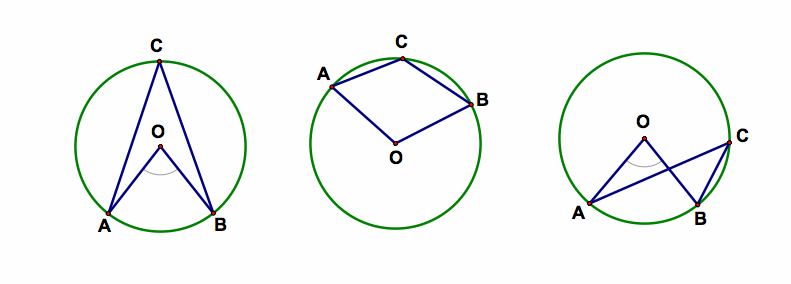
2. Using a radius of 5cm (or any suitable measure) construct three circles, each with center O as shown. Then construct the diameters AC. Now draw segments AB and CB to the point B on the circumference of the circle. Measure and state the magnitude of the angle ABC. What do you observe? Any conjecture?
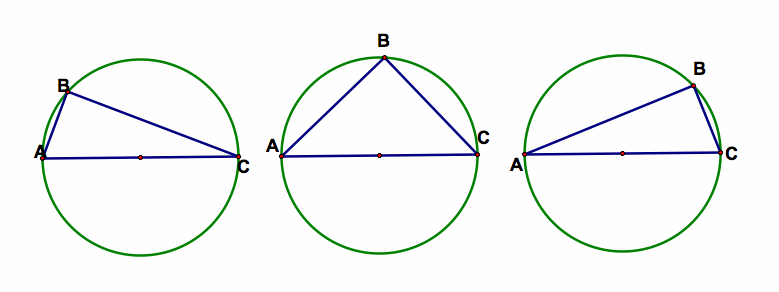
3. Using a radius of 5cm (or any suitable measure) construct three circles, each with center O as shown. Then mark off the points A, B, C, and D on your circles. Now construct segments from A to C, B to C, A to D, and B to D. Measure and State the size of each pair of angle s ACB and ADB. What is the relationship between each pair of angles ACB and ADB.
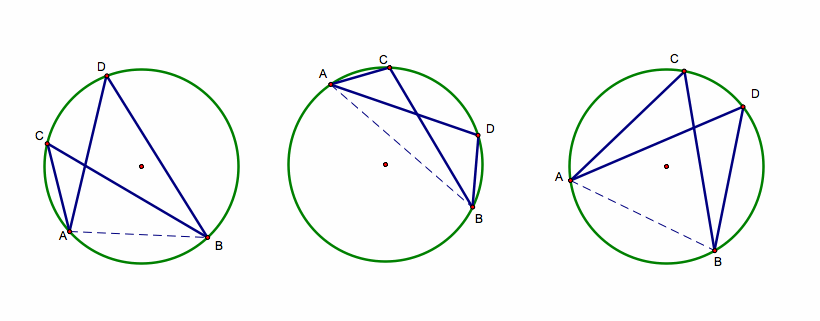
4. Angles in A Circles (From Project Intermath)
5. GSP File for further Investigation
Day 4: Chords, Secants, Tangents.
1. Intersecting Chords (From Project Intermath)
2. GSP file for investigating intersecting Secants and Tangents.
3. Given a point on a circle with center O, construct the tangent to the circle at the given point.
Here is one solution to this problem
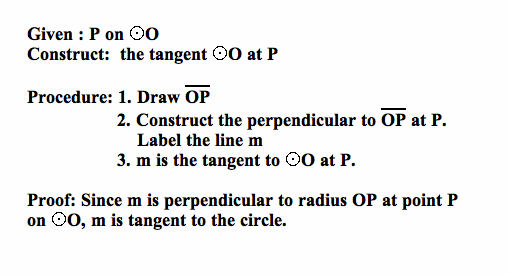 |
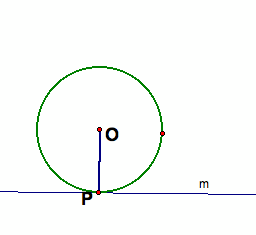 |
4. Given a point outside a circle, construct a tangent to the circle from the given point. Describe and prove the procedure that you use

5. Draw a circle with a point outside it. Construct isosceles triangle PAB with P as vertex such that segments PA, PB, and AB are tangent to the circle. (HINT: Draw OP)
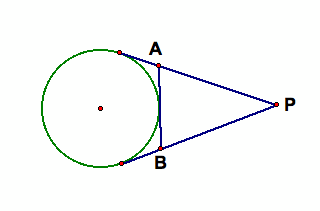
6. Draw a circle and a line l approximately as shown.
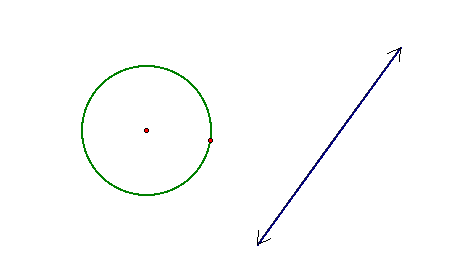
(a) Construct a line tangent to the circle that is parallel to l.
(b) Construct a line tangent to the circle that is perpendicular to l.
7. Consider circles Q and P with radii r[1] and r[2] respectively as shown. The dotted circle has radius r[1] - r[2].
Study the figure and create a method for constructing a common external tangent to circles Q and P.

9.
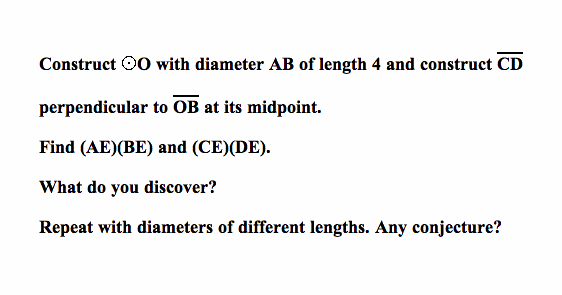 |
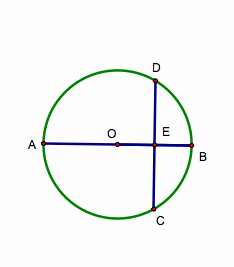 |
Day 5 : Intersecting Circles
2.
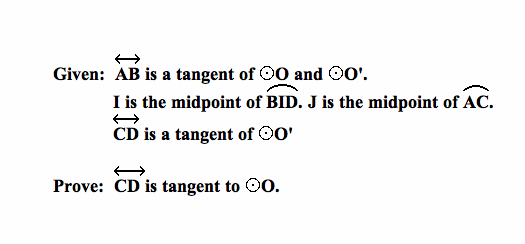 |
 |
3.
Day 6 : Great Circles
A sphere is a solid consisting of an infinite set of points which are all equidistant from a fixed point call the center. This distance of a point from the center is called the radius. for example a basket ball or a ball bearing. For simplicity, the earth, the sun and the planets are considered to be spheres of different radii.
Here is a Power point that may be used as introduction to spheres.
Historical Note
Bernhard Riemann (1826- 1866) was the first person to consider a geometry in which the parallel postulate was replaced with the following postulate.
Through a given point not on a given line, there exist no lines parallel to the given line.
Riemann geometry was closely associated with a sphere and the remarkable idea that because a line is an undefined term, a line on the surface of a sphere is different from a line on a plane. Despite this difference, it seems reasonable that spherical line should retain some properties of lines on a plane. For instance, on a plane the shortest distance between two points is a straight line containing the points. The line that connects the points is an example of what is called a geodesic.
Definition of Geodesic : A geodesic is a curve C on a surface S such that for any two points on C, the portion of C between these two points is the shortest path on S that joins these two points.
On a sphere the geodesic between two points is a great Circle that connects the points.
Definition of Great Circle: A great circle of a sphere is a circle on the surface of the sphere whose center is at the center of the sphere. Any two points on a great circle divide the circle into two arcs. The shorter arc is the minor arc and the longer is the major arc.
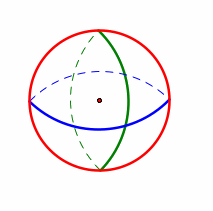
Exploration Using Model
Materials: Polystyrene ball, scissors, tape. straight pins
Procedure:
|
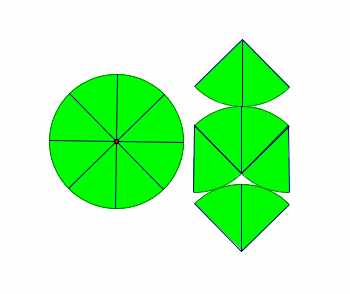 |
Questions:
Estimate how much of the total surface of the sphere was covered by the pattern.
What is the area of the pattern in terms of r, the radius of the sphere?
Write a formula for the surface area of the sphere.
1. Surface Area
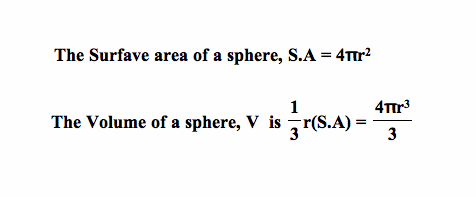
Example:

2. A Solid Sphere of diameter 14cm contain a conical space in one of its hemisphere as shown in the diagram above. Calculate the volume of the yellow region. Here are two ways of thinking about this problem:
 |
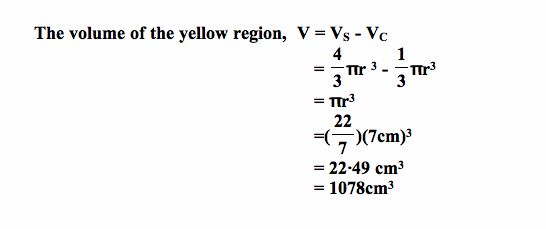 |
Day 7-10:Problem Solving
"Putting it Together"
By this time in the unit students should be able to solve all the TASKS in Unit Three of The Georgia Performance Standard Unit 3.